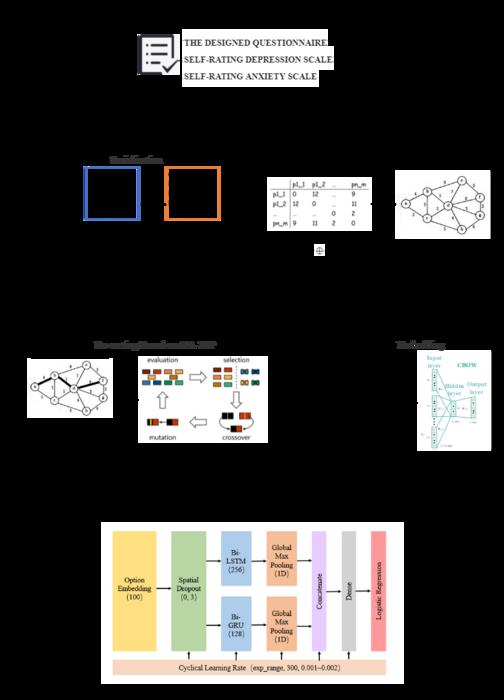Prenatal depression poses a significant threat to the health of pregnant women, increasingly recognized for its detrimental impact on both mental and physical well-being. Over recent years, there has been a noteworthy rise in cases of prenatal depression, often leading to postpartum issues. This highlights an urgent need for effective early detection methods and deeper understanding through sound attribution analysis. Addressing these challenges requires innovative approaches rooted in advanced technological methods, which can harness data-driven insights to inform and improve reproductive health practices.
To tackle this pressing issue, a research team led by Xiaosong Han has contributed groundbreaking findings by introducing a pioneering method aimed at detecting prenatal depression. The team’s study, titled “SEOE: an option graph based semantically embedding method for prenatal depression detection,” was published in the esteemed journal Frontiers of Computer Science on December 15, 2024. This research illustrates a blend of computer science and health science, creating a novel intersection that could revolutionize how healthcare practitioners identify and treat prenatal depression.
The study proposes a unique detection methodology that utilizes a semantically enhanced option embedding (SEOE) model, designed to systematically analyze and represent questionnaire options concerning prenatal depression. The approach allows researchers to quantitatively assess the intricate relationships and discernible patterns hidden within questionnaire responses. This marks a significant advancement in constructing more precise and responsive analysis mechanisms in the realm of mental health screening.
A critical step in this study involves the quantification and reordering of options through SEOE. Recognizing that the effectiveness of tools like Word2Vec heavily depends on contextual accuracy, the researchers innovatively transformed the reordering process into an optimization challenge akin to the traveling salesman problem. This thoughtful adjustment ensures that related responses are closely aligned, effectively minimizing discrepancies that might skew results.
Furthermore, the research harnesses the capabilities of Word2Vec models to train the vector representations of all questionnaire samples. By leveraging the strengths of deep learning, the final detection model integrates Long Short-Term Memory (LSTM) networks alongside Gated Recurrent Units (GRU), underpinned by a cycle learning rate. This fused model is adaptive, exhibiting a powerful synergy that enhances the detection of depressive states among pregnant women, demonstrating both robustness and efficiency.
Validation of the SEOE model involved rigorous comparative analysis against traditional machine learning frameworks as well as various deep learning methodologies. The results were promising, showcasing the model’s ability to identify cases of prenatal depression with remarkable accuracy, achieving an F1 score of 0.8. Such findings are not only indicative of the model’s operational strengths but also underscore its potential utility across different psychiatric questionnaires, marking a pivotal step toward broader applications in mental health research and diagnosis.
This research demonstrates the profound implications of technological integration into healthcare practices, particularly in nascent areas such as mental health and prenatal care. By identifying affected individuals efficiently, healthcare providers can embark on timely interventions tailored to the unique needs of each patient, thus improving overall outcomes. As prenatal depression can have long-lasting effects on both the mother and child, the stakes of such advancements are exceedingly high.
Moreover, the applicability of the SEOE model extends beyond the realm of prenatal depression. The methodologies adopted may serve as a template for future research, potentially targeting other psychiatric disorders by employing similar semantic embedding techniques to derive insight from varied questionnaires. This kind of versatile application is a hallmark of successful research in the realm of computer science, bolstering its importance and appeal in addressing public health matters.
As prenatal depression garners appropriate attention within the scientific community, the responsibilities of policymakers and healthcare leaders become increasingly significant. Strategies must be devised to incorporate these findings into practice, fostering a proactive stance against this growing concern. The integration of such research findings into public health policy could facilitate the establishment of screening programs that focus on at-risk populations, ultimately contributing to healthier maternal and child outcomes.
The collaboration between technologists and healthcare professionals provides a sustainable framework for future innovations. Such partnerships are vital as they bring diverse expertise together, empowering the development of solutions that not only understand the clinical dimensions of problems but also harness computational strength to solve them. These joint efforts hold the promise of reshaping prenatal care paradigms, ushering in an era where technology-driven insights can meaningfully blend with compassionate healthcare principles.
In summary, the research led by Xiaosong Han presents an exciting frontier in the realm of prenatal depression detection. With a solid methodological foundation and promising results, the SEOE model has arrived at a time when the need for effective screening methods is paramount. As the scientific community continues to refine and enhance these technological tools, momentum will build towards developing a comprehensive understanding of mental health during pregnancy. This research serves as not only a beacon of hope for future inquiries but also a call to action for health systems worldwide to prioritize the integration of cutting-edge techniques into everyday practice.
Given the rising awareness and significance of mental health issues faced by expectant mothers, the need for continuous research and development remains a priority. The potential impacts outlined in this study and its subsequent applications are poised to drive further inquiry and innovation. As we look ahead, collaborative research efforts and the sharing of insights will be crucial in ensuring the development of health strategies that acknowledge the importance of mental well-being during one of the most critical phases of life.
Subject of Research: Prenatal Depression Detection
Article Title: SEOE: an option graph based semantically embedding method for prenatal depression detection
News Publication Date: 15-Dec-2024
Web References: Link to the journal article
References: DOI: 10.1007/s11704-024-3612-4
Image Credits: Credit: Xiaosong HAN, Mengchen CAO, Dong XU, Xiaoyue FENG, Yanchun LIANG, Xiaoduo LANG, Renchu GUAN
Keywords
Applied sciences and engineering; Computer science





